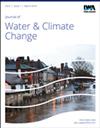马来西亚降雨季节变化模拟的Tweedie模型
IF 3.1
4区 环境科学与生态学
Q2 WATER RESOURCES
引用次数: 0
摘要
摘要本研究旨在评估Tweedie广义线性模型在表征马来西亚半岛18个气象站的月降雨模式方面的适用性。它采用正弦和余弦函数组成的调和函数作为季节预测因子,El Niño南方涛动(ENSO)指数作为气候预测因子。结果表明,西南和西北地区需要三个调和函数,内陆和西部地区需要两个调和函数。然而,结合四个调和函数是最理想的代表东部地区。在最优季节预测模型中引入了ENSO指数的额外1个月滞后。结果表明,南方涛动指数对东部和内陆地区的月降水影响显著,而西部和西北地区的气象站与多变量ENSO指数的拟合效果较好。引人注目的是,没有观测到气候预测因子对西南地区月降雨量的实质性影响。因此,气候指数的影响很大程度上受区域地理位置的影响。重要的是,通过Tweedie模型生成的模拟数据有助于更准确地表示降雨分析中固有的统计特性。本文章由计算机程序翻译,如有差异,请以英文原文为准。
Tweedie models for Malaysia rainfall simulations with seasonal variabilities
Abstract This study aims to evaluate the suitability of the Tweedie generalised linear model for characterising monthly rainfall patterns across 18 meteorological stations in Peninsular Malaysia. It incorporates harmonic functions consisting of sine and cosine functions as seasonal predictors and El Niño Southern Oscillation (ENSO) indices as climatic predictors. Results indicate that three harmonic functions are essential to accurately portray rainfall dynamics in the southwestern and northwestern regions, while two suffice for the inland and western regions. However, incorporating four harmonic functions is the most optimal representation of the eastern region. An additional 1-month lag in ENSO indices is introduced to the optimal seasonal predictor model. Based on the findings, the southern oscillation index notably impacts monthly rainfall significantly in eastern and inland areas, while meteorological stations in the western and northwestern areas fit better with the multivariate ENSO index. Strikingly, no substantial impact of climate predictors is observed on the monthly rainfall within the southwestern region. Thus, the influence of climate indices is very much influenced by the geographical locations of the regions. Importantly, generating simulated data through the Tweedie model contributes to a more accurate representation of the statistical properties inherent in rainfall analysis.
求助全文
通过发布文献求助,成功后即可免费获取论文全文。
去求助
来源期刊

Journal of Water and Climate Change
WATER RESOURCES-
CiteScore
4.80
自引率
10.70%
发文量
168
审稿时长
>12 weeks
期刊介绍:
Journal of Water and Climate Change publishes refereed research and practitioner papers on all aspects of water science, technology, management and innovation in response to climate change, with emphasis on reduction of energy usage.
 求助内容:
求助内容: 应助结果提醒方式:
应助结果提醒方式:


